When people think about the highest region on Earth, they imagine the snowy Himalayas and Buddhist monks dressed in bright robes. And while Tibet may sound to some like an incredibly remote region, those who are fortunate enough to visit it may find that the images they have of Tibet are quite right, with snow caps atop the towering Himalayan peaks and Buddhism still an important life part for many Tibetans. Tibet is indeed an enigmatic region, a place that makes travelers feel connected with nature at a deeper level. It’s a corner to contemplate the passage of time.
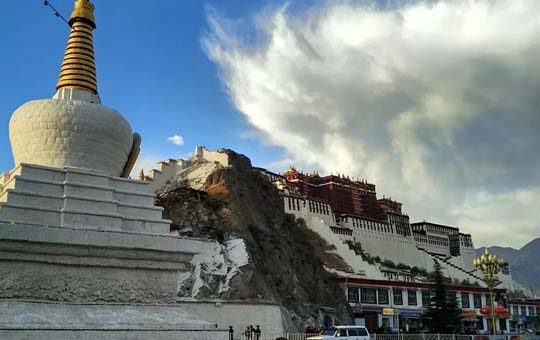
Things to Do and Travel Advice
Most visitors come to Tibet for two things: the mystical culture of Tibetan Buddhism and the stunning alpine landscapes. While Tibet is indeed an enigmatic region, visitors don't need to go too far away from Lhasa to check off some of the top sights that Tibet has to offer.
Located at the center of Lhasa and overlooking the city, Potala Palace was once the chief residence of the Dalai Lama and remains the most magnificent and iconic building in Tibet. Potala Palace is full of religious treasures and relics and is no doubt a must-see for all visitors whilst in Lhasa.
About 2 kilometers from Potala Palace lies Jokhang Temple, the most sacred temple in Tibetan Buddhism. Being an important pilgrimage site for all Tibetans, visitors can see lots of people doing repeated prostrations and worshipping on the pavement outside the temple. Encircling Jokhang Temple, Barkhor Street is an atmospheric 1km circuit flanked by traditional Tibetan houses, and is a good place to people watch and soak in the authentic Tibetan atmosphere.
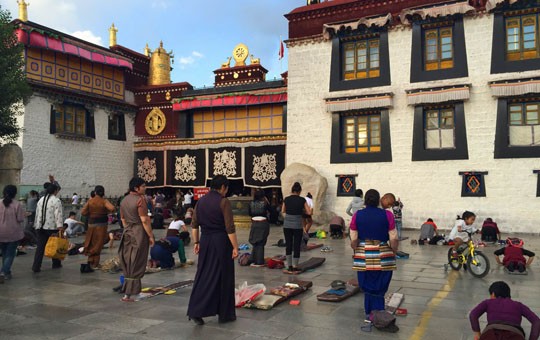
For visitors who want to see more temples, Drepung Monastery and Sera Monastery are two splendid temples on the outskirts of the city and can be visited conveniently whilst in Lhasa. Both of the temples belong to the “Great Three” Tibetan monasteries of Lhasa.
About 2.5 hours' drive southwest of Lhasa, Yamdrok Yumtso Lake is one of the three holy lakes of Tibet. Sitting at an altitude of about 4600 meters and surrounded by snow-capped mountains, Yamdrok Lake is famous for its mysterious turquoise-blue waters and is regarded as one of the most beautiful lakes in Tibet. The drive from Lhasa to Yamdrok Lake winds around the Tibetan countryside, featuring traditional dwellings as well as scenic mountains and valleys. As you progress into the mountains, the picturesque alpine views become even more breathtaking.
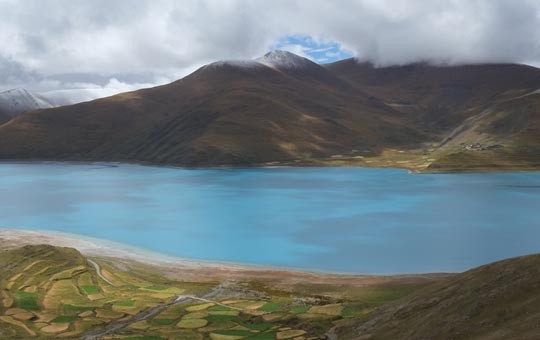
Adventure lovers may want to visit the Everest Base Camp and come face to face with Mt. Qomolangma, the highest mountain in the world. Along the way, visitors can stop and visit Yamdrok Lake, the Karola Glacier, the Palkhor Monastery and Kumbum Stupa in Gyantse, and Tashilhunpo Monastery in Shigatse. In addition to these amazing sights, the drive from Lhasa to Everest Base Camp itself features stunning alpine scenery.
Three days is usually enough for visitors who only want to stay in Lhasa and visit the highlight sights that the Tibetan capital and nearby area have to offer. If you want to visit Everest Base Camp and the famous sights along the way, it normally requires 4 extra days due to the long distance. If you are planning to visit Tibet on your China adventure, please check out the popular sights and activities here and our most popular Tibet itineraries here, or you can simply ask us to customize an itinerary for you.
One important thing to keep in mind is that the air in Tibet has 40% less oxygen, and most visitors are likely to suffer a certain level of altitude sickness. Symptoms include headaches, shortness of breath, and nausea. Although most visitors will find that the symptoms are manageable and do not affect their travel in Tibet, a few may experience more severe symptoms. Visitors should consult their doctor before traveling to Tibet. While in Tibet, do not overexert yourself, and always pace yourself when climbing stairs or hills.
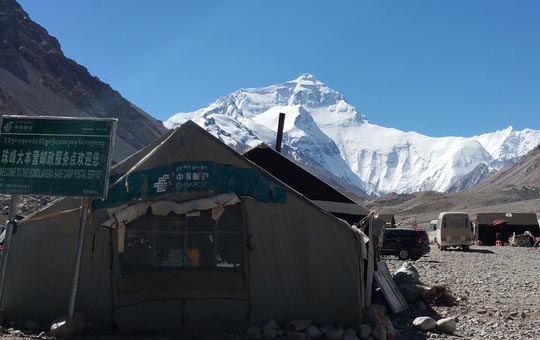
Another notorious feature of Tibet is its public restrooms. Although the government is rebuilding some of Tibet’s public restrooms to meet modern standards, visitors will find most public bathrooms quite dirty and stinky, with no flush toilets, even at many popular sights. The bathrooms are even worse outside Lhasa. A mask might help you deal with the odor in some of the worst places.
While there are good hotels in downtown Lhasa, hotels can be quite basic in more remote areas.
You should avoid photographing policeman or soldiers in Tibet, or in the rest of China, as this can get you in trouble. In general, it is best not to photograph people without their permission, and please note that some temples only allow photography for a fee.
Staying Healthy in Tibet
Daytime and nighttime temperatures vary a lot in Tibet. Temperatures may drop quite low at night even in summer. Stay warm and wear layers to avoid illness or exhaustion while in Tibet. A cold could develop into a more serious lung condition in the dry, high-altitude conditions of the plateau region.
Drink enough water to stay hydrated while traveling. Have some high-energy snacks with you, such as dried fruit, nuts, chocolate, etc. This can help you to regain lost energy quickly and combat exhaustion. It is best not to overeat in order to reduce the burden on your stomach and digestive system. It is recommended to avoid alcohol and cigarettes, and instead eat vegetables and fruits that are rich in vitamins. Dehydration and fatigue can cause or increase altitude sickness and should be avoided.
The sun is very strong in the plateau region, so sunglasses and sunscreen are musts in order to protect your eyes and skin. A wide-brimmed hat will also help guard you from the sun. The climate is particularly dry, and lotion and lip balm are recommended.
Eating in Tibet
The traditional Tibetan diet is simple and basic, largely limited to barley, meat (mutton or yak), and dairy products, and may not be to everyone’ taste. But Chinese dishes and cooking methods have been introduced in Tibet, so it is usually easy to find Chinese-style dishes while traveling in Tibet.
Being the capital of Tibet and a popular tourist destination, Lhasa features many good restaurants and teahouses serving Tibetan dishes along with Chinese dishes, as well as some Western food like pizza, pasta, sandwiches, etc. Some local fare you should try include yak meat with vegetables, Tibetan noodles in broth, momos (steamed or fried dumplings filled with yak meat or vegetables), and yak butter tea (salty tea churned with butter).
If you are traveling to remote areas in Tibet, it may be difficult to find quality restaurants serving diversified dishes. We recommend carrying some snacks or pre-packaged food, especially for longer journeys.
Best Time to Visit Tibet
Generally, May to June and September to mid-October are the best times to visit Tibet, as the weather is warm and comfortable during the day, and nights are chilly but not freezing. In addition, the weather is usually clear and the views of the mountains, including Mt. Everest, are at their best during these months.
Summertime, from July to August, is also a good time for traveling in Tibet. Although this is the rainy season, most of the rainfall occurs in the evening or at night, leaving the daytime free of rain and ideal for traveling.
For visitors who only want to visit Lhasa and its adjacent area, the winter months, from November to April, are also a good choice. The temperature during the day is still warm and there are far less travelers than during the more popular months, although there is a sharp drop in temperature at night. However, be aware that winter is not suitable for visiting areas at higher elevation, like Mt. Everest Base Camp or Namtso Lake, since the mountainous roads to these places become icy and may be closed due to snow.
Another thing to keep in mind when planning a trip is that Tibet is usually closed to foreign tourists for a certain period every year, usually in February or March, around the Tibetan new year.
Average Temperatures in Lhasa
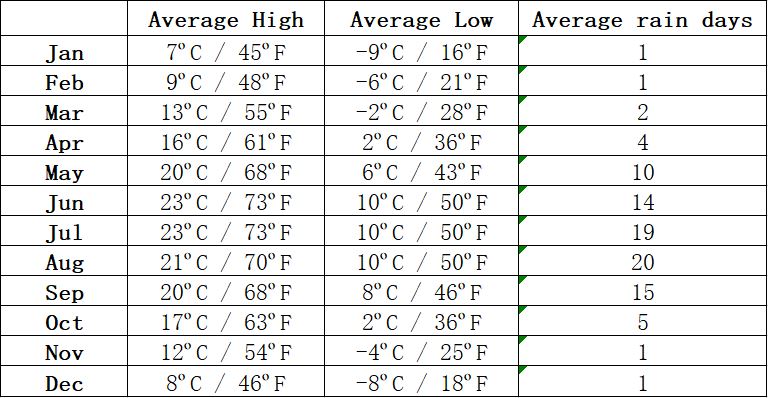
How to Travel to Tibet
Foreign visitors can travel to Tibet via train and airplane from a number of other cities within China. Overland routes to Tibet from Sichuan or Yunnan provinces have been closed to foreign travelers since 2009.
The train from Beijing to Lhasa takes just over 40 hours, meaning you have to spend two nights on the train. It is often said that traveling to Tibet by train gives you enough time to adjust to the high altitude since you ascend gradually. However, you may not sleep well on the train, which could add to your altitude sickness. In addition, most travelers have limited time when traveling in China, so we usually suggest that our guests fly to Lhasa and adjust to the altitude before heading to places at higher elevation.
Every foreign traveler that wishes to visit Tibet must do so with a travel agency. This is the rule and there are absolutely no exceptions. Every trip to Tibet must be arranged in advance.
The first thing that any traveler must do is obtain a visa from the Chinese embassy in their home country. Next, the travel agency will apply for the Tibet Travel Permit. Without the Tibet Travel Permit, foreign travelers will not be allowed to board flights or trains to Tibet. The timing is also extremely important. Visitors should contact a travel agency at least a month in advance since most travel permits for Tibet take a minimum of fourteen days to arrange.
Visitors can also apply for a Chinese visa and a Tibet Travel Permit with the Chinese Embassy in Kathmandu, Nepal. Again, this can only be done through a travel agency but the procedures are different from traveling to Tibet from within China.
Although some travelers may think that traveling to Tibet sounds like too much trouble, it’s important to remember that the travel agency takes care of pretty much all of the required documents, and travelers don’t really need to worry about them. If you have questions about the process or need further information, please contact The China Guide team.
Tibet/Lhasa Private Tours
- Beijing and Tibet Highlights Tour - 10-day Beijing, Lhasa, Gyantse and Shigatse tour
- Sleep at Mt. Everest Base Camp - 9-day Lhasa, Gyantse, Shigatse, Mt. Everest tour
- More tours in Tibet...
